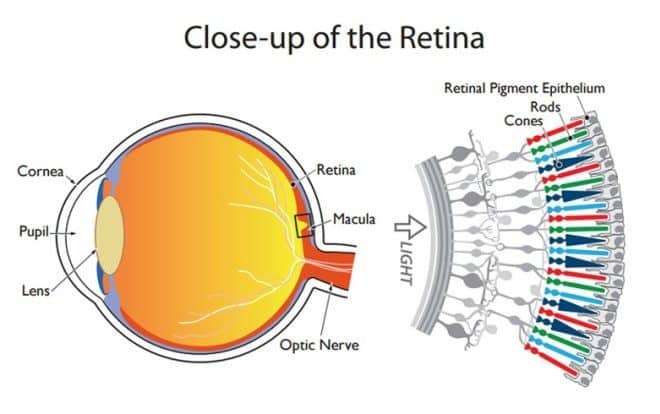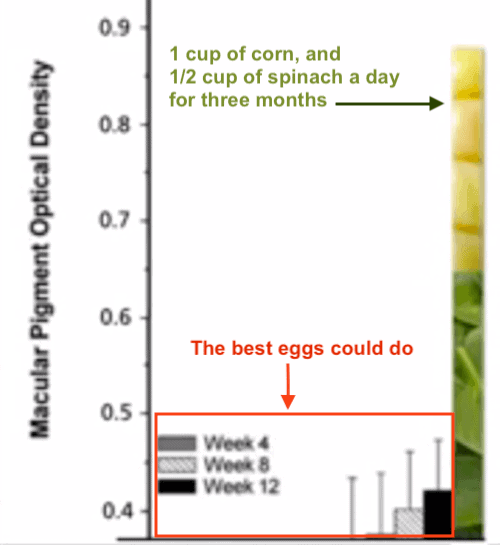How To Save Your Eyesight From Aging (with food), Part 2
You can help save your eyesight by eating specific phytonutrient-rich, cartenoid-based foods that can protect your eyes’ pigmentation and prevent, or even reverse, advanced macular degeneration, which impairs the vision of many of us as we age.
LAST WEEK in Part 1, I examined a list of phytonturient-rich, cartenoid-based supplements that studies show can help save your eyesight by preventing, and even reversing, advanced macular degeneration (AMD), which impairs the eyesight of a significant amount of us as we age.
Now, here in Part 2, I dig into what foods can help prevent or help lessen AMD, courtesy of Dr. Michael Greger, a nutrition expert and Founder of NutritionFacts.org.
In this article, you’ll discover:
- That yellow plant pigments such as lutein and zeaxanthin build up in the back of our eyes to protect our retinas against age-related macular degeneration.
- What to eat to help save your eyesight with specific phytonurient-rich foods.
Let’s dig in…
A Quick Summary of Part 1
For those of you who haven’t read it, here’s a bit about what we learned in Part 1:
“Age-related macular degeneration (AMD) is a problem with your retina. It happens when a part of the retina called the macula is damaged. With AMD you lose your central vision. You cannot see fine details, whether you are looking at something close or far. But your peripheral (side) vision will still be normal. For instance, imagine you are looking at a clock with hands. With AMD, you might see the clock’s numbers but not the hands.”
We also checked out a study done by the National Eye Institute (NEI), which recommends these vitamin supplements to save your eyesight from aging:
- 500 milligrams of vitamin C
- 400 international units of vitamin E
- 80 mg zinc as zinc oxide
- 10 mg lutein and 2 mg zeaxanthin
To the above mix, I added BioAstin Hawaiian Astaxanthin, given Dr. Joseph Mercola’s recommendation to use astaxanthin to support eye health (as well as a host of other health benefits), and my own positive experience with the supplement.
Now, let’s turn to how AMD, and your overall eye health, can be improved by specific foods.
Save Your Eyesight with Phytonutrient-rich Foods
You may digest information about how specific foods can save your eyesight by either watching Dr. Greger’s short video or reading my summary of it. You’ll leave here better informed if you do both.
To watch this video on Dr. Greger’s website, go here.
For those of you who would rather read than watch a video, I’ll summarize what Dr. Greger has to say, extract a graph from the video and, inevitably, add my commentary and suggestions.
Beware damaging UV rays
If you’ve ever got a sunburn you know that UV rays in sunlight can damage your skin. Now imagine what those same UV rays are doing to the back of your eyeballs, the retinas.
Our eyes focus sunlight like a magnifying glass on to the back of our eyes. Thankfully, we have a layer of cells in our eyes, called the retinal pigment epithelium, that supports and protects our delicate retinal eyesight machinery. This layer builds up yellow plant pigments from our diet, like zeaxanthin, which absorbs blue light, and protects the retina from the photo-oxidative damage.
I touched on zeaxanthin in Part 1 of this two-part series. It’s one of three macular caroteniod — zeaxanthin, meso-zeaxantin and luten — found in nature, in foods and manufactured in vitamin supplements.
The Best Food Source To Save Your Eyesight
It’s not widely known, but the yellowing of the lenses in our eyes when we get cataracts may actually be our body’s defense mechanism to protect our retinas, says Dr. Greger. This may pose a big downside to surgically removing those cataracts.
When cataracts in our eyes are removed, the risk of blindness from macular generation spikes, because that the cataracts can no longer protect the retina. Dr. Greger suggests that:
Instead of trading one type of vision loss for another, instead of pigmenting the front of your eyes with cataracts, better to pigment the back of our eyes with diet. The pigment in the back of our eyes is entirely of dietary origin—thus suggesting that the most common cause of going blind in the Western world could be delayed, or even averted, with proper dietary change.
Eat what the chicken eats, not what she lays
What in our diet can nourish our eye pigmentation?
The egg industry brags that eggs are a good source for the phytonutrients you need, such as zeaxanthin. But have an egg nearly every day—six eggs a week—for three months, and the pigmentation in our eyes barely moves, even if those eggs consumed are high-lutein, free-range, certified organic eggs.
Yes, eggs can increase zeaxanthin levels in the blood, but they also raise bad cholesterol levels (LDL), and risk of heart disease, says Dr. Greger; so he recommends an alternative to an egg yolk-based, high-cholesterol dietary strategy to increase plasma zeaxanthin.
Instead of getting the phytonutrients indirectly from the egg, which came from the chicken that ate the corn, and blades of grass that nourished her sufficiently to produce the egg, why not get them from the same sources as the chicken?
Check out the following graph (which is a bit cloudy given that it’s a screen capture from Dr. Greger’s video):
Affect of Eggs vs Veggies On Eye Pigmentation
That cup of corn and a half-cup of spinach a day for three months resulted in a dramatic boost in protective eye pigment, almost twice that provided by eating eggs.
But there’s more!
In the study that produced the results indicated in the above graph, researchers measured the eye pigmentation density levels three months after the study stopped. Surprisingly, the high density levels were largely maintained. As Dr. Greger puts it:
… once we build up our macular pigment with a healthy diet, our eyeballs really try to hold on to it. So, even if we go on vacation, and end up eating more iceberg lettuce than spinach, our eyes will hold on until we get back.
So, what if corn and spinach ain’t your thing?
What other egg-alternative, high-phytonutrient, zeaxanthin-rich cholesterol-free food source is both desirable and can boost levels of protective eye pigmentation?
Well, according to WebMD, the following 14 foods should be liberally and consistently consumed to help save your eyesight from aging:
- Spinach (lutein and zeaxanthin)
- Kale (lutein and zeaxanthin)
- Brussel Sprouts (vitamin C)
- Stawberries (vitamin C)
- Grapefruit (vitamin C)
- Carrots (beta carotene)
- Pumpkin (beta carotene)
- Sweet potato (beta carotene)
- Salmon (omega-3 fatty acids)
- Sardines (omega-3 fatty acids)
- Herring (omega-3 fatty acids)
- Seeds (vitamin E)
- Nuts (vitamin E)
- Wheatgerm (vitamin E)
What about Goji Berries?
Goji berries have up to 60 times more zeaxanthin than eggs. A small handful of goji berries markedly increases zeaxanthin levels in our body, and offers an effective, safe, whole food strategy to increase zeaxanthin in the bloodstream.
But we don’t need it in our blood; we need it in our eyes.
Apparently, this was tested by a study reviewed by Dr. Greger in his video above, but I couldn’t discern an explicit reference to whether consuming goji berries might result in more zeaxanthin in our eyes. What was emphasized is that the carotenoid pigments in the goji berries made a difference in minimizing the loss of eye pigmentation.
Having less pigment in the iris to protect it from sunlight, can place them at a greater risk of macular degeneration and other eye-related problems, according to the New York Times.
The study Dr. Greger cites that revealed the effectiveness of goji berries on eye health was a double-blind, randomized, placebo-controlled trial:
- Participants ate about 15 goji berries a day for three months.
- The goji berries were served with milk so the butterfat could increase the absorption of the carotenoid pigments.
- The result:
- The berries protected against loss of eye pigmentation.
- The berries prevented the buildup of what’s called “soft drusen,” which is just debris that builds up in the back of the eye—both of which are associated with age-related macular degeneration.
Note #1: Age-related macular degeneration (AMD) is “the leading cause of legal blindness” in older men and women, affecting more than ten million Americans. This study projects there will be nearly 200 million people with AMD globally in 2020, increasing to nearly 300 million in 2040.
Note #2: they gave the berries with milk in this study, so the butterfat could increase the absorption of these carotenoid pigments. Another way to get the same absorption effect of the phytonutrients in the goji berries with milk, and one more suitable to vegans, would just be to eat goji berries with nuts or seeds—in other words, goji trail mix. The nuts and seeds offer better quality fats than milk butterfat to aide absorption.
Summary:
Get Goji Berries Cheaper?
Although goji berries are probably the healthiest dried fruit on the planet, they’re typically expensive, about $20 per pound.
You may get them cheaper if you get goji berries with a different name, if an Asian market is nearby or you go to Amazon.com (see below).
Asian markets (and Amazon) offer goji berries with another name — “Lycium Berries”. As such, they can be cheaper than raisins, but only if buy enough of them.
UPDATE: According to the website WakeUpWorld, Lycium Berries are not identical to Goji Berries given that “[it has] undergone many environmental, climatic and toxic changes since it was taken from Tibet thousands of years ago and cultivated in China”. I don’t have any insights here. What I do is buy Goji Berries from reputable US brands that certify that they’re organic.
The package on the left below is Lycium Berries from China (which per the UPDATE above is probably not your best option), packaged in a 4 oz container for $7.00 on Amazon.com. The package on the right below is Goji Berries, also from China but certified organic, packaged in a 16 oz container for $16.00, which makes them cheaper on a per oz basis: $1/oz vs $1.75.
Summary:
Your Takeaway
Remember these three things:
- You can help save your eyesight from aging by shoring up the pigmentation in them.
- Phytonutrient-rich foods, like spinach and goji berries are proven to project against loss of eye pigmentation as we age.
- Eat your goji berries, or lycium berries with nuts, as the fat content in the nuts will aide absorption of the berries.
If you’d like to dive deeper into how to save your eyesight with Dr. Greger, check out these resources:
- Preventing Macular Degeneration with Diet
- Preventing Cataracts with Diet
- Dietary Treatment of Glaucoma
- Greens vs. Glaucoma
Last Updated on March 1, 2022 by Joe Garma








